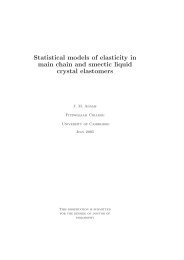Sandra Hopkins Final Report.pdf - University of Surrey
Sandra Hopkins Final Report.pdf - University of Surrey
Sandra Hopkins Final Report.pdf - University of Surrey
Create successful ePaper yourself
Turn your PDF publications into a flip-book with our unique Google optimized e-Paper software.
are more complex and can require more extensive imaging. As only one area <strong>of</strong> the heart may betreated the x-ray beam may be orientated toward the same area <strong>of</strong> the patient’s skin for longerperiods <strong>of</strong> time and has an increased likelihood <strong>of</strong> developing skin damage.2.3 Imaging2.3.1 X-ray generator and tubeThe imaging equipment used in this case is a Siemens Axiom Artis which is powered by aPolydoros 100 kW high frequency multipulse generator. The X-ray tube is a Megalix Cat 125/35/80and is dual focus (0.4 and 0.8 mm with 8 degree target angle). The imaging chain contains a flatpanel amorphous silicon (CsI scintillator) digital detector. Nominal image field sizes are 25, 20 and16 cm. Source to image distance ranges from 90 to 120cm. All fluoroscopy is pulsed with optionalpulse rates varying from 0.5 to 30 pulses per second. The digital radiography mode has anacquisition rate <strong>of</strong> 15 or 30 frames per second. A 1024 pixel matrix is used. All modes useautomatic dose control with no manual exposure control available to users. There are copper dosesaving filters available on this system with filter thicknesses which vary from 0.1 to 0.9 mm Cu.The use <strong>of</strong> these filters is automatically linked to the programme selected by the user and is basedon the X-ray absorption by the patient. Filtration is available for both fluoroscopy and acquisition.2.3.2 Flat plate detectorTechnical developments in imaging have meant that many systems that previously had an imageintensifier as the detecting medium now have a flat plate detector. In this case the caesium phosphorconverts x-ray photons to light photons. The amorphous silicon is sensitive to light and converts thelight to an electrical signal. The light is captured by a ‘pixel’ in the photodiode/thin film transistor(TFT) array and converted into an electronic signal. Contrast resolution is improved by reducing thetemperature as this results in less noise. A key difference resulting from using a digital detectorinstead <strong>of</strong> an image intensifier is that digital detectors result in very little image distortion.Additionally high contrast resolution improves with magnification using an image intensifierwhereas resolution remains constant with a digital detector since the resolution is determined bypixel size.6
















